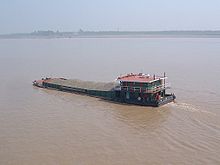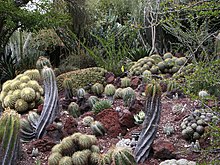


Crushed stoneorangular rock is a form of construction aggregate, typically produced by mining a suitable rock deposit and breaking the removed rock down to the desired size using crushers. It is distinct from naturally occurring gravel, which is produced by natural processes of weathering and erosion and typically has a more rounded shape.

Crushed stone is a major basic raw material used by construction, agriculture, and other industries. Despite the low value of its basic products, the crushed stone industry is a major contributor to and an indicator of the economic well-being of a nation.[5] The demand for crushed stone is determined mostly by the level of construction activity, and, therefore, the demand for construction materials.[6]
Stone resources of the world are very large. High-purity limestone and dolomite suitable for specialty uses are limited in many geographic areas. Crushed stone substitutes for roadbuilding include sand and gravel, and slag. Substitutes for crushed stone used as construction aggregates include sand and gravel, iron and steel slag, sintered or expanded clayorshale, and perliteorvermiculite.[7]


Crushed stone is a high-volume, low-value commodity. The industry is highly competitive and is characterized by many operations serving local or regional markets. Production costs are determined mainly by the cost of labor, equipment, energy, and water, in addition to the costs of compliance with environmental and safety regulations. These costs vary depending on geographic location, the nature of the deposit, and the number and type of products produced. Crushed stone has one of the lowest average by weight values of all mineral commodities. The average unit price increased from US$1.58 per metric ton, f.o.b. plant, in 1970 to US$4.39 in 1990. However, the unit price in constant 1982 dollars fluctuated between US$3.48 and US$3.91 per metric ton for the same period. Increased productivity achieved through increased use of automation and more efficient equipment was mainly responsible for maintaining the prices at this level.[6]
Transportation is a major factor in the delivered price of crushed stone. The cost of moving crushed stone from the plant to the market often equals or exceeds the sale price of the product at the plant. Because of the high cost of transportation and the large quantities of bulk material that have to be shipped, crushed stone is usually marketed locally. The high cost of transportation is responsible for the wide dispersion of quarries, usually located near highly populated areas. However, increasing land values combined with local environmental concerns are moving crushed stone quarries farther from the end-use locations, increasing the price of delivered material. Economies of scale, which might be realized if fewer, larger operations served larger marketing areas, would probably not offset the increased transportation costs.[6]
According to the United States Geological Survey, 1.72 billion tons of crushed stone worth $13.8 billion was sold or used in 2006, of which 1.44 billion tons was used as construction aggregate, 74.9 million tons used for cement manufacture, and 18.1 million tons used to make lime. Crushed marble sold or used totaled 11.8 million tons, the majority of which was ground very fine and used as calcium carbonate.
In 2006, 9.40 million tons of crushed stone (almost all limestone or dolomite) was used for soil treatment, primarily to reduce soil acidity. Soils tend to become acidic from heavy use of nitrogen-containing fertilizers, unless a soil conditioner is used. Using aglime or agricultural lime, a finely-ground limestone or dolomite, to change the soil from acidic to nearly neutral particularly benefits crops by maximizing availability of plant nutrients, and also by reducing aluminum or manganese toxicity, promoting soil microbe activity, and improving the soil structure.
In 2006, 5.29 million tons of crushed stone (mostly limestone or dolomite) was used as a flux in blast furnaces and in certain steel furnaces to react with gangue minerals (i.e. silica and silicate impurities) to produce liquid slag that floats and can be poured off from the much denser molten metal (i.e., iron). The slag cools to become a stone-like material that is commonly crushed and recycled as construction aggregate.
In addition, 4.53 million tons of crushed stone was used for fillers and extenders (including asphalt fillers or extenders), 2.71 million tons for sulfur oxide removal-mine dusting-acid water treatment, and 1.45 million tons sold or used for poultry grit or mineral food.
Crushed stone is recycled primarily as construction aggregate or concrete.
The term "high performance bedding" (HPB) is used to refer to 1/4" and 3/8" crushed rock.
Granular A, Granular B, and Granular C, all represent crushed rock mixed with sand in which Granular A has the least amount of sand, and Granular B has the most amount of sand. "Granular A" is also referred to as "angular crushed down to fines" or "minus" gravel.[8]

The strength and stiffness of the course of compacted angular stone came from the mechanical interlock which developed between individual pieces of stone. The principle is still used in modem road construction and since 1820 McAdam's name has been remembered by the term macadam used to describe the courses of unbound angular stone which he introduced.
Crushed stone can be used without binder for a variety of construction or industrial applications, or it may be mixed with a matrix binding material, such as bituminous or portland cement.